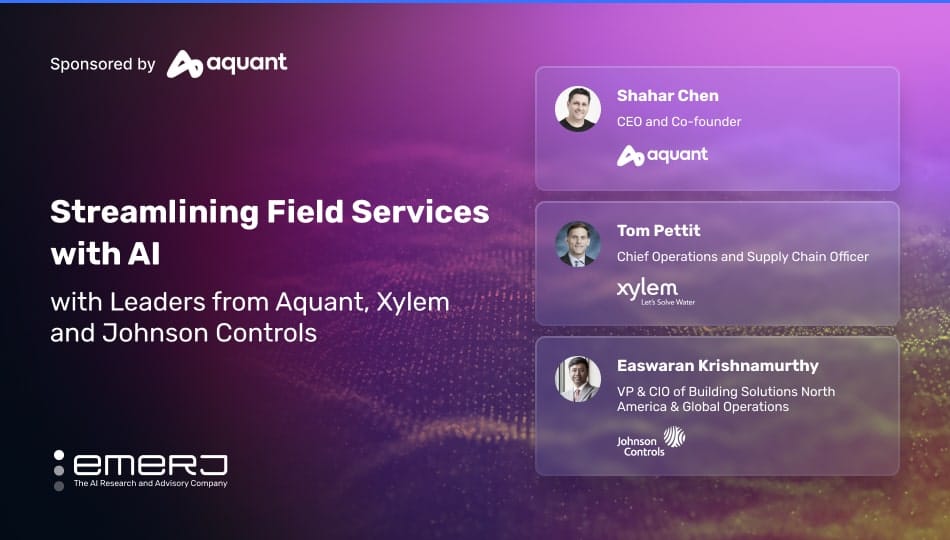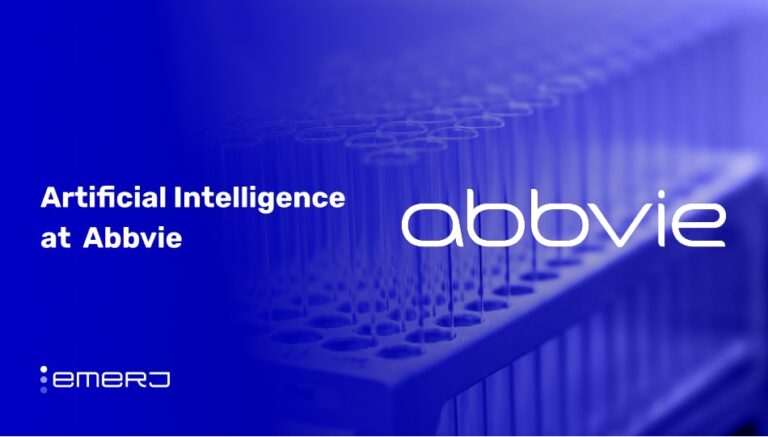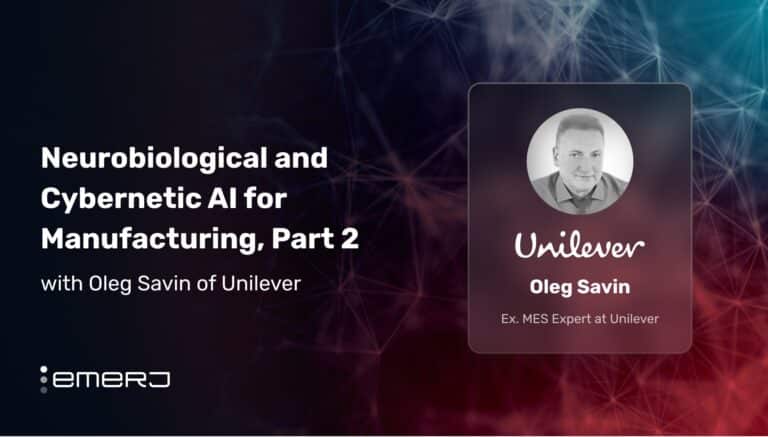This interview analysis is sponsored by Aquant and was written, edited and published in alignment with our Emerj sponsored content guidelines. Learn more about our thought leadership and content creation services on our Emerj Media Services page.
As the impact of AI continues to shape B2c workflows, its influence on B2b processes reveals a nuanced landscape with diverse implications for various industries and businesses.
Notably, the field services domain stands out as a sector rife with challenges, particularly where the reliability of the machinery becomes a life-or-death concern. Take for instance the production of essential medical equipment like heart rate monitors for hospitals. Unlike consumer products, where malfunctions might cause users some inconvenience, the B2b realm – especially in field services – can introduce heightened stakes.
Given the need for extra-human diligence for driving safety protocols and efficiency in these systems, it is telling that Blumberg Advisory Group recently released an industry report sponsored by Zuper that showed almost 40 percent of professionals in field service management and related businesses believe that AI will enhance route optimization and job prioritization throughout their sector in the near future.
Aquant, a vendor that develops an AI-enhanced copilot platform, seeks to bridge the gaps in B2b field services workflows using similar technologies proven to deliver successful ROI in B2c contexts from financial services to retail. Between the efficiencies the industry sees in AI applications across B2c workflows, Aquant envisions bringing them to even more challenging B2b disciplines, such as the intense producer-customer relationships within field services.
The following analysis features insights into conversations with field service leaders who recently appeared in a special series of Emerj’s ‘AI in Business’ podcast. Throughout, the article examines how AI, copilots and augmented reality all are already helping field service leaders in logistics and heavy machinery spaces optimize resource utilization, bridge knowledge gaps and deploy quick, untested assistance to technicians through safer virtual environments and alternatives to physical reality.
Expert guests featured in the series include Shahar Chen, CEO and Co-founder of Aquant; Tom Pettit, Chief Operations and Supply Chain Officer of water management firm Xylem; and Easwaran Krishnamurthy, Vice President and Chief Information Officer for Building Solutions at Johnson Controls. Each guest brought a career’s worth of industry experience to their conversations, particularly on how new cutting-edge AI-enhanced and adjacent technologies like augmented reality, virtual reality and generative copilots are already growing into pioneering use cases in the field services space and all the industries they touch.
The article further focuses on three key insights from their conversations:
- Increasing accuracy and efficiency with copilots: The distinct advantages of using AI-enhanced copilots to navigate complex tasks and problem-solving in manufacturing and adjacent industries to streamline operations, expedite decision-making, optimize resource utilization and bridge knowledge gaps.
- Using AR and VR to enhance B2b services: Leveraging augmented reality (AR) and virtual reality (VR) to address workforce challenges and improve efficiency in B2B=v services, emphasizing their potential in remote assistance, learning and proactive problem-solving.
- Implementing augmented reality for technician training: Using augmented reality platforms to quickly bring new, inexperienced technicians up to speed on various machines in a safe virtual environment.
Increasing Accuracy and Efficiency with Copilots
Episode 1 – AI Solutions for B2B Customer Experiences
Guest: Shahar Chen, CEO and Co-founder, Aquant
Expertise: Generative AI, Business Solutions and Business Development
Brief Recognition: Shahar is the CEO and Co-founder of Aquant. He has previously worked at ClickSoftware as the Director of Solution Center. He received a Bachelor’s in Computer Science at Bar-Ilan University, Israel in 2002.
During his appearance on the podcast, Shahar outlines three key areas for the executive audience where he believes AI will have a significant impact, all of which are tied back to improving operational uptime in manufacturing and adjacent industries:
- Predictive Maintenance: Shahar identifies predictive maintenance as a crucial enterprise capability impacted by AI. Traditionally, achieving predictive maintenance has been a long-term goal for many. Now with the step-level advancements in AI capabilities over the last few years in computer vision and beyond, it is a use case with widespread applicability across sectors and more easily achievable ROI than considered by c-suites in years prior. The idea is to anticipate when equipment will likely fail and then perform maintenance proactively moving that date forward as far as business leaders can, preventing costly downtime. Shahar emphasizes that, in management resource planning, enacting proactive enterprise capabilities can be up to 100 times cheaper than reacting to a failure after it occurs.
- Intelligent Diagnostics or Troubleshooting: Once a machine has already broken down, the focus shifts to getting it back up and running as quickly as possible. Shahar tells the podcast audience that AI can assist in guiding users through a series of questions to identify the root cause of the problem, allowing for more efficient and targeted problem resolution.
- Advantages of Copilots: Shahar defines a copilot as a generative AI system that works alongside a human operator, providing guidance and assistance. He appreciates that a copilot doesn’t take over or “autonomize” the role. Instead, copilots help navigate and fill knowledge gaps, ensuring that the human operator remains in control but operating to the best of their abilities. A collaborative approach is essential when specific expertise is needed, such as troubleshooting network issues in the technician example Shahar discusses later in his appearance.
He also talks about the post-sale phase, where providing customer support becomes crucial. He identifies a substantial gap in the manufacturing industry in meeting customer expectations and addressing issues that arise after product shipment.
At this point Shahar emphasizes to the podcast audience that a key factor contributing to the support challenge is the need for more experienced talent in the workforce. He notes that in the past, employees would accumulate extensive experience within a single company over several decades, unlike today.
However, job tenures have shortened dramatically across industries over the last two decades, limiting the opportunity for individuals to gain in-depth knowledge and expertise. He suggests that AI technologies can provide support, analyze issues and bridge the knowledge and experience gaps caused by the changing dynamics of the workforce:
“When you’re talking about copilots for specific industries like manufacturing or service, or any of these, it becomes even more critical that the answer will be accurate, and it will take time for you to get to the right answer without calling the guy that might be on a conference call for four hours, or maybe the guy retired yesterday. He’s no longer available, but you’ll still know. So it’s the knowledge that tests what’s in the head of your employees, what’s in their mind, as an experience that they’ve gained. Today that knowledge is becoming the IP of the company, the IT of the manufacturing company. Then through AI, it stays in the organization forever.”
–Shahar Chen, CEO and Co-founder, Aquant
In so doing, AI can contribute to meeting customer expectations in the B2b context that maintain and nurture the fundamental business relationships across manufacturing and logistics spaces that make reliable supply chains possible throughout the world.
Shahar then shares a real-world field services example involving a technician with whom he has a personal relationship and worked with in complex industrial printing equipment for 30 years. He explains to the podcast audience that despite being highly knowledgeable about the mechanical aspects of the equipment, the technician told Shahar that he felt incredibly insecure about his familiarity with network issues in the digital era.
Shahar points out that AI can address the technician’s challenges by troubleshooting and guiding end-users through problem-solving processes – even for systems they are wholly unfamiliar with, such as networking issues in the case of said technician – before a senior technician with that experience can be dispatched to the field.
Using AR and VR to Enhance B2B Services
Episode 2 – Collecting Data for B2B Customer Experience Challenges
Guest: Tom Pettit, CSCO – Chief Operations and Supply Chain Officer, Xylem
Expertise: Cross-functional team leadership, supply chain, change management
Brief Recognition: Tom Pettit is the Chief Operations and Supply Chain Officer at Xylem. He oversees all Xylem operations, driving customer experience, operational excellence, information technology, lean continuous improvement and simplification across the company globally. He completed his Master of Business Administration from the University of Hawaii.
Xylem provides technologies, solutions and services to address water challenges across public and private sectors, including waste-water management. Their business operates almost exclusively in heavy industry field service contexts.
Given his subsequent and extensive experience in field services serving in his current role and beyond, Tom begins his podcast episode appearance by addressing the challenges related to a skills crunch in the workforce, particularly with the retirement of senior technical personnel and the need to transfer their knowledge to newer workers. He emphasizes the need to enhance the productivity and learning speed of lesser experienced employees.
To achieve a maximally efficient knowledge transfer, Tom suggests leveraging technologies like augmented and virtual reality to facilitate collaboration between senior and junior technicians, especially when dealing with complex problems. Another focus is ensuring efficient technician deployment by utilizing data to avoid wasted trips, optimizing routes and reducing time spent by the technician searching for equipment. The goal is to maximize technician hours for truly revenue-generating work.
“We’ve got a lot of senior technical people retiring and the younger workforce aren’t as technical, so we need to be able to help them be more productive and learn faster. So there are things that we can do, such as augmented reality and virtual reality. Maybe you have a senior skilled technician remote who can help a more junior, less skilled technician with a thorny problem using augmented or virtual reality.”
– Tom Pettit, CSCO – Chief Operations and Supply Chain Officer at Xylem
Among the specific data categories Tom suggests leveraging to enhance technician diagnostics and problem-solving, he mentions fault codes repeatedly and specifically. He describes the capability to input fault codes and engage in interactive learning based on the experiences of previous technicians.
Through various workflows, the system prompts technicians to follow predetermined steps and solve problems more efficiently. In turn, Tom emphasizes the role of simple machine learning capabilities in prescribing step-by-step processes for technicians in this format by leveraging historical data. The approach aims to reduce the enterprise’s reliance on traditional tribal knowledge and skills tranfers, allowing AI and machine learning to provide technicians with relevant information, making them more effective and efficient in their roles.
Tom also highlights the simplicity of some of these solutions, suggesting that, even without advanced technologies like augmented- or virtual reality headsets, essential tools such as a camera on the equipment alone can be effective in achieving these outcomes for a wider range of enterprises than those who have mature digitalization initiatives. Using cameras can allow someone to observe and guide the on-site technician remotely, indicating where to look, how to move tools and what further steps to take. He notes that even smaller, less technologically-advanced setups – such as those in smaller technician shops – can benefit from these remote video capabilities to facilitate collaboration between junior and senior technicians.
Lastly, Tom outlines the critical data components required for practical remote work on field assets. The two main pieces of data identified are the asset’s identification, typically through a serial number or model number, and the corresponding drawings. To facilitate remote work, Tom emphasizes the need for an “exploded” view of the bill of materials for the equipment involved, including a service bill of materials. Such information is crucial for virtual reality systems to recognize and differentiate various components, such as the engine, alternator, filter or drive shaft.
Implementing Augmented Reality for Technician Training
Episode 3 – Leveling-Up Field Service Operations with AI
Guest: Easwaran Krishnamurthy, VP & CIO Building Solutions North America & Global Field Operations at Johnson Controls
Brief Recognition: Easwaran Krishnamurthy has been the Vice President and Chief Information Officer for the Building Services division of Johnson Controls since July 2022. With more than two decades of experience in the IT industry, he has worked with FieldCore as a Chief Information Officer, with CocaCola Enterprises as an IT Director for Commercial Applications and Enterprise Mobility and with Philips Medical Systems as Sr. Business Analyst in Logistics. He received his B.E. in Electronics from RV College Of Engineering.
Expertise: Digital transformation, Solution & Enterprise Architecture, Sales & Marketing Automation
Johnson Controls provides operations, maintenance, repair and integrated facility management services throughout field services-related industries. Drawing from his role in global field operations, Easwaran underscores the substantial advantages of augmented and virtual reality, particularly in employee training for technicians – echoing sentiments expressed in Tom Pettit’s previous podcast appearance in the series as well.
Easwaran emphasizes the efficiency of quickly bringing technicians up to speed on various machines in a safe virtual environment. He introduces the concept of a digital twin, where a system’s activities are mirrored in a virtual platform that mimics the data output of its assigned counterpart in real time. Such a digital twin would serve for training, monitoring and understanding a field asset’s status and performance in crucial points of the B2b producer-customer relationship.
He provides two examples of how data, specifically through generative AI, is utilized in the context of digital twins:
- Tech Advisor Application: First, Easwaran discusses a tech advisor application that analyzes historical service ticket data. Generative AI can then advise technicians based on past problem resolutions, enabling them to understand potential solutions before reaching the service site and expediting the resolution process.
- Predictive Repairs: The second example pertains to the product lifespan of equipment. By establishing rule engines, generative AI can guide technicians during service, suggesting additional maintenance based on historical data for similar equipment at the service site. A data-driven approach enhances decision-making and potential upselling opportunities from there, leveraging the distinct capabilities of generative AI for more informed and efficient equipment servicing for future offerings.
Easwaran also underscores the importance of driving new generative AI systems to ensure information will be presented to technicians in a user-friendly way:
“That’s the critical piece of the puzzle, because if you go and ask the technician to use 15 different tools while he’s at the customer site, he or she is not interested in doing it. Most of the time, everything needs to work in their own mobile application. So the question becomes, ‘How do you collect all the necessary data with various dependents, populate data in a user interface using generative AI on data from traditional reporting, but then deliver it in a way that the technician can easily consume?'”
– Easwaran Krishnamurthy, VP & CIO Building Solutions North America & Global Field Operations at Johnson Controls
Easwaran finally concludes by emphasizing that, it’s not just about having the data but providing true visibility into the insights of the data that technicians need and in a manner they can readily understand, then act upon. User experience (UX) is crucial to the process, as the goal is to facilitate technicians in comprehending and utilizing the information effectively during their daily tasks.

















